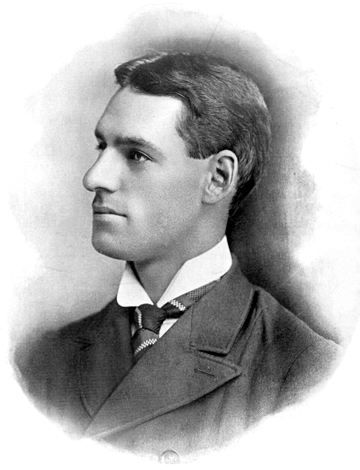
Class of 1894 | Over the years, Penn has sent more than 50 horsehide-swatting alumni to the Major Leagues. But with all due respect to Doug Glanville EAS’93, Mark DeRosa W’97, and sundry others, the greatest of them all played a century ago, from 1899 to 1911, mostly for the Philadelphia Phillies. His name was Roy Thomas W1894.
During his 13 seasons, Thomas was one of the National League’s most productive table-setters, and his relentlessly patient at-bats infuriated opponents and prompted the National League to change its rule regarding foul balls. By taking as many as 115 walks in a season, he compiled a .413 career on-base percentage (OBP), which according to baseball-reference.com makes him the Phillies’ all-time leader in that category. That, and his admirable .290 lifetime batting average, earned him a marker in the Phils’ new Citizens Bank Park. Yet despite those accomplishments—not to mention the fact that he later coached Penn’s baseball team for 11 years, compiling an outstanding winning record and producing nine Major Leaguers in the process—he is not listed in either Penn’s Athletic Hall of Fame or its Baseball Hall of Fame.
Thomas came to Penn in 1890, enrolling at Wharton. He began making a name for himself as an outfielder, and by 1892 was a varsity player. In 1894 he was the star of a team that must rank as one of the most professionally successful teams in history. It boasted four future Major Leaguers, one football All-American and future College Football Hall of Famer (and veterinary surgeon), seven future physicians, one future lawyer, and two future dentists. One of those dentists, substitute pitcher and outfielder Pearl Z. Gray D1896 Hon’17, would become the wildly prolific Western
novelist Zane Grey [“Dentist of the Purple Sage,” March/April 2004].
After graduating in 1894 Thomas joined a team of college standouts that beat several National League teams in exhibition games. He attracted the attention of the Phillies, who signed him in 1898, and quickly became a star, batting .325 his rookie year with a .457 OBP via 115 walks, and immediately establishing himself as the Phils’ leadoff hitter and center fielder.
He soon became the perennial league leader in walks, but his method infuriated the opposition. At the time foul balls were not counted as strikes, and Thomas, who became adept at fouling off good pitches, worked an astonishing number of free passes.
The issue came to a head in 1900. Late in a close game against the Cincinnati Reds, Roy Thomas fouled off a dozen pitches before drawing a walk. The pitcher, Bill Phillips, responded by punching Thomas. Phillips had seen Thomas’ tactics before. In an earlier game Thomas had fouled off 27 pitches against him in one at bat. Then, in a game against the Brooklyn Superbas (as the Dodgers were known then), Thomas was again fouling off numerous good pitches until he was walked. The opposing manager was predictably angry. Only this time the manager was Ned Hanlon, who was on the National League’s Rules Committee. Hanlon shouted from the dugout: “Have your fun now, kid, because we’re going to take care of you for next year.”
Sure enough, the Rules Committee met after the season and changed the foul-strike rule so that fouls before the third strike count as strikes; the American League followed suit in 1903. Ironically the rule-change had little effect on Thomas. After the new rule went into effect, he led the league in walks six out of the next seven seasons. According to Thomas, “calling strikes on earlier fouls simply handicapped the less experienced players.”
As his career wound down, Thomas became Penn’s baseball coach, and actually continued playing professionally while coaching for three seasons. Thomas coached from 1909 to 1919, and was as good a coach as he was a player. Though records are sketchy, he compiled a record of 106-43-3 for a .632 winning percentage, comparable to the best college coaches of all time. He coached nine future Major Leaguers at Penn, as well as one Negro Leaguer, Douglass Sheffey D’23. Sheffey played from 1920 to 1923 and quickly established himself as the ace of a staff that also featured future Major Leaguer Walt Huntzinger W’22. Had he been white, Sheffey would have certainly played Major League baseball. After their big-league careers, many of Thomas’ players went on to success in other fields. One of them, Pius “Pi” Schwert W’14, became a U.S. Congressman.
Roy Thomas’ most lasting legacy is the rules change he forced. But he also left a playing record that has endured. He is 20th all-time in walk percentage, 26th all-time in OBP, and 72nd all-time in walks. Furthermore, according to legendary baseball analyst and writer Bill James, Thomas is the only Major League regular to have scored three times as many runs as he drove in.
Thomas was very loyal to Penn. At one time he was president of his class, and regularly wrote notes to the Gazette announcing the births of grandchildren and even great-grandchildren.
Buried in his file at the University Archives and Records Center is a letter from an alumnus complaining that Penn officials didn’t notice Thomas’ death in 1959, observing that “the greatest baseball player in Penn’s history passes with no recognition whatsoever.” Perhaps now his legendary patience is finally paying off.
— Stephen Eschenbach




